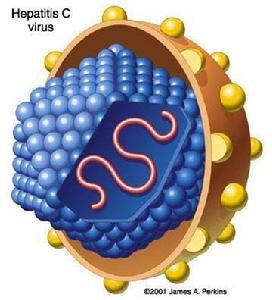摘要:近日,来自洛克菲勒大学和斯克斯普斯研究所的科学家们成功地构建出了第一个人源化丙型肝炎遗传工程小鼠模型,这一研究成果将推动研究人员研发出用于人类身上的丙肝疫苗。相关研究论文在线发表在6月9日的《自然》(Nature)杂志上。
针对丙型肝炎病毒(HCV)感染的治疗方法的研究工作,一直受阻于缺少一种有关这种疾病的小型动物模型。现在,Alexander Ploss及其同事介绍了丙型肝炎病毒感染的第一个有免疫活性的啮齿类动物模型,他们利用表达四个人类因子的腺病毒使HCV能够进入小鼠细胞。这些病毒载体然后被用来转导小鼠的肝脏,后者于是便变得对HCV感染有易感性了。虽然这个模型并不能实现一个完整的病毒复制周期,但它对于评估HCV疫苗及入侵抑制因子的有效性应当是有用的。

丙型肝炎病毒
Hepatitis C virus (HCV) remains a major medical problem. Antiviral treatment is only partially effective and a vaccine does not exist. Development of more effective therapies has been hampered by the lack of a suitable small animal model. Although xenotransplantation of immunodeficient mice with human hepatocytes has shown promise, these models are subject to important challenges. Building on the previous observation that CD81 and occludin comprise the minimal human factors required to render mouse cells permissive to HCV entry in vitro, we attempted murine humanization via a genetic approach. Here we show that expression of two human genes is sufficient to allow HCV infection of fully immunocompetent inbred mice. We establish a precedent for applying mouse genetics to dissect viral entry and validate the role of scavenger receptor type B class I for HCV uptake. We demonstrate that HCV can be blocked by passive immunization, as well as showing that a recombinant vaccinia virus vector induces humoral immunity and confers partial protection against heterologous challenge. This system recapitulates a portion of the HCV life cycle in an immunocompetent rodent for the first time, opening opportunities for studying viral pathogenesis and immunity and comprising an effective platform for testing HCV entry inhibitors in vivo.







